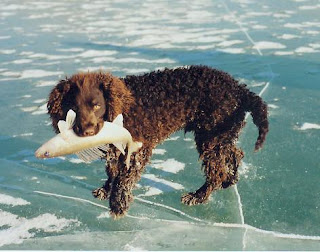The American Water Spaniel, (often
abbreviated to AWS), is a breed of spaniel which originated in the United
States. Developed in the state of Wisconsin during the 19th century from a
number of other breeds, including the Irish and English Water Spaniels. The
breed was saved by Dr. Fred J. Pfeifer, who set up the breed club and standard,
and whose work led to recognition for the breed by the United Kennel Club, and
later, the American Kennel Club. While they are the state dog of Wisconsin,
they remain a rare breed.
They
are medium-sized dog, and have a double layered coat, which comes in a variety
of brown related shades. A versatile hunting dog, they are also suitable for
apartment life due to work by breeders to develop a breed with an even
temperament. The AWS may have been involved in the development of the Boykin
Spaniel.
Appearance
The
limited popularity of the American Water Spaniel restricted development,
resulting in the breed being relatively unchanged since its origins in the 19th
century. They are a medium-sized dog, with a curly liver, brown, or chocolate
colored coat. The average height at the withers for the breed is 15–18 inches
(38–46 cm), and their weight around 25–45 pounds (11–20 kg). They have similar
features to the Irish Water Spaniel, but the Irish breed is larger at between
21–24 inches (53–61 cm) and weighing 55–65 pounds (25–29 kg). The coat of the
American Water Spaniel can fall in two different patterns, either tightly
curled or in the "marcel pattern" where the fur falls in waves.
Working and show lines have not diverged as with some other breeds of spaniel,
and both appear the same, with show dogs of this breed being rare.
The
coat has a coarse outside layer which keeps water away and protects the dog
from foliage such as briers. The inside layer provides insulation to keep the
dog warm. The coat has an oily feel to it, which gives off a "doggy
smell". The breed standard specifies color of the eyes should harmonize
with the color of the coat, and should never be yellow. The skull is broad, and
carries long, wide ears. The tail is not typically docked.
Temperament
In
the field, the AWS is less exuberant than the English Springer Spaniel, but it
is as skilled in retrieval as Labrador or Golden Retriever. It is versatile
regardless of the type of terrain, and in the water it is not the fastest
swimmer but has a high level of endurance. The breed is also good at agility
and flyball, with the first of the breed receiving a flyball championship title
in 1993.
Members
of the breed enjoy being the center of attention, and can be quite vocal at
times. It is a one family dog, and will often bond with one particular
individual. For many years the breed was "pack bred", where they were
allowed to live in a group. Since these times, breeders have been working to
breed even tempered dogs that are suitable for both hunting and family life.
The
AWS has a mind of its own at times and reaches peak performance with the owner
who is dedicated to teaching the dog just what is expected of it. The breed
takes well to training, and especially excels at training that offers some
variety rather than routine training drills. However, members of the breed can
may have issues with food possessiveness. They can be stubborn, and mentally
are slow to mature from puppyhood. Some lines of the breed still retain
dominant and aggressive temperaments; other than these lines, the AWS gets on
well with children and enjoys playing with them. Even though they were
originally bred to hunt, due to their size, they are suitable for apartment
living as long as they receive enough exercise.
Health
Pack
breeding early in its development led to a level of genetic variation, so the
hereditary conditions of more popular breeds are not common in the AWS. The
breed however is known to suffer from eye issues including cataracts and
progressive retinal atrophy. Inheritance is suspected in both conditions, with
the average age of cataract onset at under one year old.






No comments:
Post a Comment